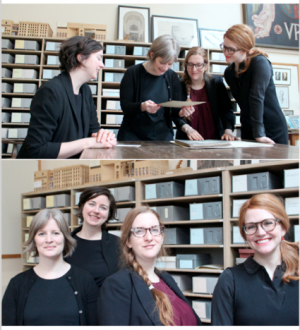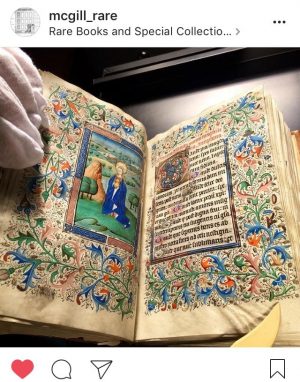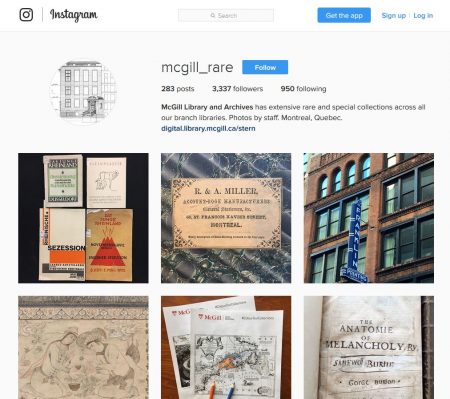February 19 marks the one year anniversary of the McGill_Rare Instagram account. 365 days and over 3,300 followers later, this social media initiative, started by four McGill librarians, continues to develop an online following made up of bibliophiles and people who love to look at all things good and beautiful.
The collective established by Robin Desmeules, Assistant Librarian, Collection Services; Anna Dysert, Assistant Librarian, Osler Library of the History of Medicine; Jennifer Garland, Associate Librarian, Rare Books and Special Collections; and Sarah Severson, Assistant Librarian, Digital Initiatives, makes it their mission to share a diversity of materials that represent many subjects and collections at McGill. From Islamic calligraphy to tiny children’s books, the Instagram posts generate user questions about the library’s rare holdings and digital collections, a dialogue that benefits both librarian and audience. The posts are thoughtfully curated to match themes, events, anniversaries, and collective Instagram hashtag “challenges” such as #ManuscriptMonday, #Canadiana150, #styleinthestacks, and #100daysofvimy.
McGill_Rare is getting noticed in professional circles as well. In September 2016, the team was selected from hundreds of institutional accounts from around the world by Fine Books & Collections online magazine as one of 18 great rare book Instagram feeds. In December, the McGill_Rare feed was featured in Canadian Art magazine as a resource that that shows McGill Library’s use of the medium to “visualize[e] its extensive holdings”.
The collective spoke to Library Matters about their busy inaugural year.

Bottom photo L to R: Sarah Severson, Jennifer Garland, Robin Desmeules, Anna Dysert. Credit: Merika Ramundo
Library Matters (LM): How do your different areas of expertise inform the content?
McGill_Rare (MR): We came together as a group organically. Sarah and Jennifer established the account as a natural extension of ongoing RBSC collection digitization. It didn’t take long before Robin and Anna were invited to contribute with material that crosses their desks. We all see our collections differently since we look at items with different distinct purposes in mind—some of us see more through the lens of teaching and collecting, others through cataloguing and digitization.
One of the most interesting aspects about this type of collaborative work is that we learn more about our collections because we are seeing them through our colleagues’ eyes. For example, in Robin’s work as a cataloguer, she examines and describes all aspects of the book, from binding to page marginalia – she’s great at finding details buried within the pages of a book. Anna’s subject expertise in medieval and early modern book history feeds our audience’s interest in manuscripts, chained books, and scrolls. Sarah has the institutional memory for all of the previously digitized material in our online exhibitions and websites. She pores over this content and matches images to upcoming dates in our calendar. Jennifer’s posts from the John Bland Canadian Architecture Collection highlight architectural plans and photographs that are uncatalogued and more difficult for users to find.
LM: Do you have any tips/tricks on how you work together to produce a cohesive feed?
MR: Communication and trust is key. Practice and community have also informed our posting guidelines. We’ve created loose documentation of those guidelines to keep us on track and to facilitate communication. It helps that we have a limited number of people posting so that there aren’t “too many cooks in the kitchen”. We are also very flexible and supportive of last minute changes when a great new item surfaces or to make room for our #mcgillrareontheroad posts that highlight our professional development and travel.

McGill_Rare Instagram post. Book of Hours manuscript | c. 1450 | Rare Books & Special Collections | MS 98 #mcgillrarebooks #bookofhours #illuminatedmanuscript
LM: Talk a bit about something you posted that was surprisingly received.
MR: We’ve learned that our audience loves tiny things! Our tiny book posts are among the most popular to date, along with medieval manuscripts. It’s a real treat to read the comments and online conversations between people about certain posts. Sometimes the questions we get on title pages have been delightful – people really want to unpack these things. Every day we are learning more and more about what people want to see. The Instagram provides a platform for immediate feedback, which is useful in helping to shape future content and directions.
LM: What institutions inspire you with their Instagram feed?
MR: We received lots of comments and encouragement from the americanantiquarian feed. They immediately made us feel part of the library Instagram community. We also enjoy Northwestern University’s Transportation Library Instagram feed for initiating cool challenges like their “libraryloveisloveislove” posts. We also enjoy the feed from the W.D. Jordan Library of rare books and special collections at Queen’s University in Kingston, Ontario.
LM: What’s your favourite part about working with a visual medium like Instagram?
MR: We work in a very visual, hands on environment so it’s wonderful (and fun!) to be able to share this “behind the scenes perspective” with our users and community. Plus we’re already taking photos of these unique objects anyways so the effort on that end of things is nominal.
This platform is a great way for us to learn about our collections as well. When we see something beautiful, we dig into it a little more with research. We also get to think of the material we post in different ways that go beyond the content. For example, we post about the physical characteristics of the books: binding, typography, illustrations. We also post lived history of the book through ownership marks like binder’s tickets or bookplates. All of these characteristics are a part of the larger study of book history and print culture, and are of interest to scholars and bibliophiles alike. Access also plays a key role in how we present items. We always include the call number in our posts so people can come in with their phone and shows us the picture.
LM: What do you have planned for 2017?
MR: To celebrate Canada’s 150th anniversary this year we have co-sponsored a challenge with the Thomas Fisher Rare Book Library at the University of Toronto – #canadiana150 is a social media campaign to explore rare materials in Canadiana and we will be posting every Friday. Other areas of the McGill Library will be contributing to McGill_Rare including the McGill University Archives who will be featuring a regular #throwbackthursday photo from their collection. We are also thinking of incorporating a guest poster for a week – maybe someone working with our collection could do a series of posts on a particular theme. Lastly, we will continue to engage with the rest of the McGill Instagram community like McGill University’s main account and the McGill School of Architecture.















Leave a Reply
You must be logged in to post a comment.